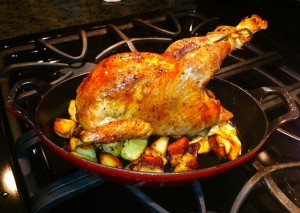↓
- For the best cooking, invest in a good thermometer. Safe internal temperature of poultry is 165 degrees, which is also when it tastes best. Cooking longer to a higher temperature tends to dry out and toughen the meat. To insure thorough cooking, measure temperature at the thickest part of the meat.
- It takes about 2 days for a whole frozen chicken to thaw in the fridge (place in a tray to collect any water or juice that could leak).
 There are two primary ways to cook chicken (or anything, really): moist heat (stewing, braising, crock-pot) or dry heat (roasting, grilling, sauteing). Experiment with both! Each can also be done at various temperatures (low heat to high heat) and times (slow cooked to quick cooked), and different methods produce difference results. For instance, long moist cooking can tenderize flavorful but tough meats (like stewing hens), while quick, dry high-heat can seal in moisture for juicy, flavorful meat (just don’t overcook!).
There are two primary ways to cook chicken (or anything, really): moist heat (stewing, braising, crock-pot) or dry heat (roasting, grilling, sauteing). Experiment with both! Each can also be done at various temperatures (low heat to high heat) and times (slow cooked to quick cooked), and different methods produce difference results. For instance, long moist cooking can tenderize flavorful but tough meats (like stewing hens), while quick, dry high-heat can seal in moisture for juicy, flavorful meat (just don’t overcook!).- Cook a whole chicken by roasting, braising (crock-pot), or even grilling (heard of beer-can chicken?) To roast, pat a thawed chicken dry with paper towel and place in a shallow baking pan, and lightly salt and pepper (other seasonings are great too, but don’t overwhelm the flavor of the meat), then place in a preheated oven. Roasting at 325 degrees, a 5-pound chicken takes an hour and a half to two hours. Some instead recommend a longer, slower roast in a 200-250 degree oven for more of a rotisserie style, while others favor a quicker cook at a higher heat of 450 degrees to really seal in juices and crisp the skin. Stop cooking at around 160 degrees, because the meat will continue to cook while resting outside the oven. Allowing roasts to rest for 10-15 minutes lets the juices redistribute and settle, so they’ll remain in the meat when cutting or carving instead of all dripping out. Carve the meat from the bones and serve.
- Rather than cooking a whole bird as-is, you can “butterfly” it by cutting the backbone in half (or cutting it out completely), then spreading the chicken flat and pressing down on the breastbone. This helps in a few ways: with the chicken a more uniform thickness, it will cook both faster and more evenly – this keeps the meat moister and prevents drying out or overcooking some parts of the bird. Additionally, this puts all the skin on top, which seals in moisture and bastes the meat, and allows all the skin to brown and crisp – a tasty treat!
- Another method is cooking whole in the crock-pot. A thawed chicken will take 3-4 hours on high, and a frozen chicken can even be cooked without thawing, on low for 8-10 hours. Place directly in the pot without extra liquid, lightly sprinkle salt, pepper, or seasonings, and slow cook.
If there is more meat then you’ll eat in one meal, keep it to use in a recipe. Meat will stay juiciest if allowed to cool completely before cutting (either refrigerate the whole carcass, or debone whole cuts of meat like the breast or thigh and cool), then dice or cut when needed. You can also freeze pieces of cooked chicken to add to casseroles, pasta or rice dishes, stir-fries, etc. when needed.
- Don’t throw away the bones! Place in a pot, add just enough water to cover, and simmer for 6 to 12 hours for a very flavorful and nutritious stock (broth) to use as a base for soups, stews, and sauces. When done boiling, pour through a strainer into glass jars. If refrigerating the stock after boiling, the fat will rise to the top and can be skimmed off when set (you can use this for cooking too…) You can also freeze bones to do a large batch at once, or freeze the stock in canning jars to use later.
- Instead of cooking chickens whole, you can cut up or bone them beforehand. Cut at the joints (a medium-length thin knife works well) to yield individual pieces of meat (breasts, wings, drumsticks, and thighs), or cut the meat away from the bone and slice or dice for grilling or sauteing. (But use those bones for stock!) If you need to freeze any, cook first – avoid refreezing thawed but uncooked meat. Enjoy!
↑
 There are two primary ways to cook chicken (or anything, really): moist heat (stewing, braising, crock-pot) or dry heat (roasting, grilling, sauteing). Experiment with both! Each can also be done at various temperatures (low heat to high heat) and times (slow cooked to quick cooked), and different methods produce difference results. For instance, long moist cooking can tenderize flavorful but tough meats (like stewing hens), while quick, dry high-heat can seal in moisture for juicy, flavorful meat (just don’t overcook!).
There are two primary ways to cook chicken (or anything, really): moist heat (stewing, braising, crock-pot) or dry heat (roasting, grilling, sauteing). Experiment with both! Each can also be done at various temperatures (low heat to high heat) and times (slow cooked to quick cooked), and different methods produce difference results. For instance, long moist cooking can tenderize flavorful but tough meats (like stewing hens), while quick, dry high-heat can seal in moisture for juicy, flavorful meat (just don’t overcook!).